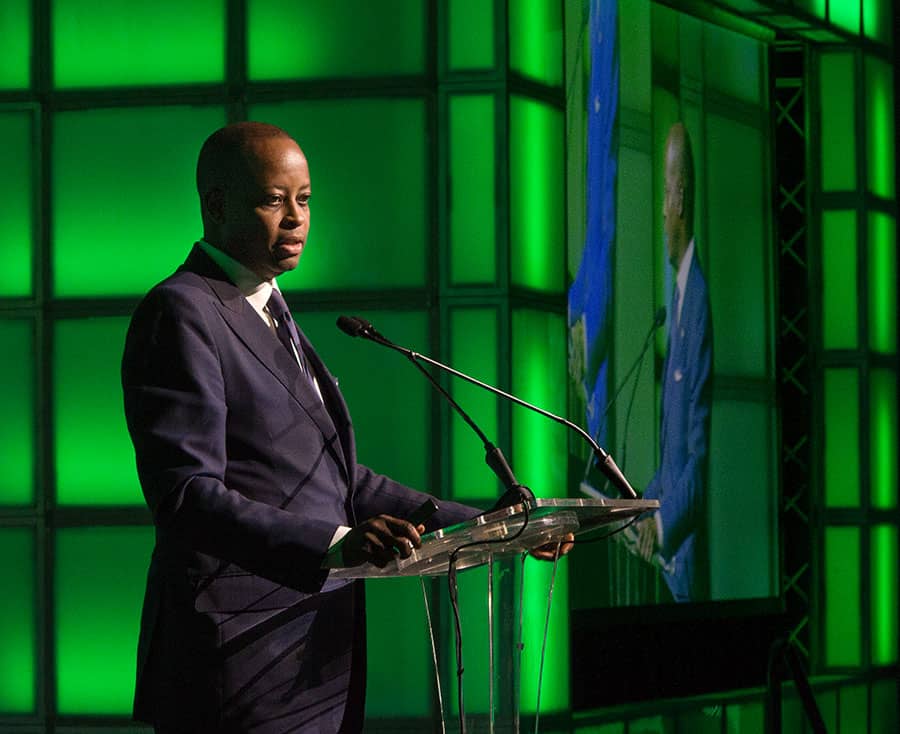
Above: Dr Wayne Frederick gives the keynote address at bmobile Connect. Photos by Mark Lyndersay.
BitDepth#1183 for February 07, 2019
The recent bmobile Connect Conference sought to be many things to ICT professionals, but its clearest messages came from its most focused speakers, particularly from Dr Wayne AI Frederick, an oncologist by profession and a thought leader by circumstance.
Frederick is the president of Howard University, one of the leading universities in the United States with a long-term commitment to diversity enrolment.
It is regarded as a “black” university because of the significant numbers of non-white students who attend and its leadership role in delivering educated people of colour (PoC) to the workplace.
According to Frederick, 34 percent of science-related bachelor’s degrees achieved by PoC’s come from Howard, which accounts for 22 percent of all bachelor’s degrees in that segment.
That hasn’t stopped Howard’s president from thinking inventively about how his students learn regardless of their background, even as he actively seeks greater opportunities for PoC in the workplace, particularly in the sciences.
“We need more science in public education,” he said.
His solution for that was the establishment of the Howard University Middle School for Mathematics and Science, a non-selective, public middle school that’s founded on the charter model, accepts students by lottery and focuses young students on STEM and the disciplines that lead into science related study programmes.
The project is as a rehearsal for the study process, with students doing university level work while they are doing the programmed curriculum.
“We talk about education in technology with a very narrow scope, and we are finding that a well-rounded individual is very important.”
“Education is a cornerstone of any development process. We have to start by looking at what our education model is and how we can change models that are based on rote learning.”
“The model of the teacher being the wisest person in the room is dated.
Dr Wayne Frederick
“The model of the teacher being the wisest person in the room is dated. Every classroom should be an incubator lab where everyone has something to contribute.”
In support of that, all faculty at Howard will be encouraged and given the time to do computer science training.
There have also been physical changes at Howard in support of these initiatives. The IN3, an Inclusive Innovation Incubator, is an 8,000 square foot science exploration space that has been established to provide 50 co-working spaces to support ideas and projects under development.
So inventing hardware isn’t the crux of the problem, designing initiatives that engage students with their future is.

In a presentation track at the conference, Kelton Edwards of Huawei showed a packaged solution designed for university campuses, a mix of technology, platforms and systems called the Agile Campus Smart Solution that includes a 100 gigabit network capable of supporting 5,000 simultaneous users without lag.
Finding that African-Americans total just one percent of the technology workforce, Frederick teamed up with Google to address the disparity.
What resulted was an internship programme for Howard University computer science students. Fifty percent of the first cohort to participate in the programme were offered jobs in the technology industry and 75 percent of the jobs were in Silicon Valley.
To address the required curriculum changes, teachers worked alongside Google engineers and that’s changed the perspectives of the teaching body.
And it’s not just Google. Frederick has worked with businesses, US Chambers of Commerce and Mastercard to create interventions with teachers and students that shape the learning process to greater effectiveness and relevance.
As impressive as those initiatives are, Frederick was blunt about the challenges in making such major changes happen.
“Changing the teaching process is slower than moving a battleship, it’s like moving a flotilla.”
Frederick urged his audience to work with TSTT and UWI to develop the students of the future.
“Employers end up investing two years training new recruits to be skilled at the work, and then they may move on.”
“Education is a cornerstone of any development process,” Frederick said.
“We don’t spend enough time talking about what we measure. What do you see as success in the organisation?”



